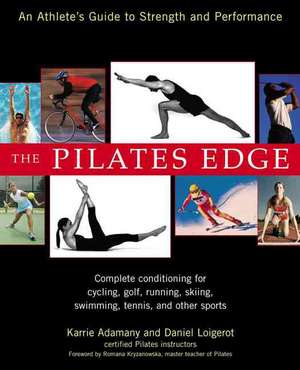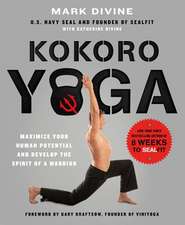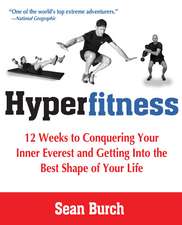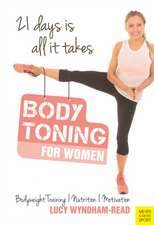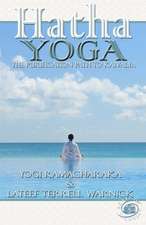The Pilates Edge: An Athlete's Guide to Strength and Performance
Autor Karrie Adamany, Daniel Loigeroten Limba Engleză Paperback – 31 ian 2004
Complete body conditioning for golf, running, tennis, swimming, cycling, skiing, and other sports and activities.
Originally developed by Joseph Pilates for boxers, gymnasts, and dancers, Pilates is a unique body-conditioning method that teaches precision movement generated from the center of the body-the "powerhouse"-which includes the abdominal muscles, lower back, and buttocks. The Pilates Edge demonstrates how the basic principles of Pilates can enhance sports training and promote athletic achievement as well as everyday health and fitness.
With this instructive book, athletes and anyone seeking to improve their physical performance will learn to strengthen and condition their bodies while preventing injuries through a basic Pilates workout, designed with variations for beginner and advanced levels. The authors provide specific workouts for golf, running, racket sports, swimming, cycling, and skiing, giving special attention to the muscle groups and common injuries associated with each sport.
Originally developed by Joseph Pilates for boxers, gymnasts, and dancers, Pilates is a unique body-conditioning method that teaches precision movement generated from the center of the body-the "powerhouse"-which includes the abdominal muscles, lower back, and buttocks. The Pilates Edge demonstrates how the basic principles of Pilates can enhance sports training and promote athletic achievement as well as everyday health and fitness.
With this instructive book, athletes and anyone seeking to improve their physical performance will learn to strengthen and condition their bodies while preventing injuries through a basic Pilates workout, designed with variations for beginner and advanced levels. The authors provide specific workouts for golf, running, racket sports, swimming, cycling, and skiing, giving special attention to the muscle groups and common injuries associated with each sport.
Preț: 145.58 lei
Nou
Puncte Express: 218
Preț estimativ în valută:
27.87€ • 30.28$ • 23.42£
27.87€ • 30.28$ • 23.42£
Carte disponibilă
Livrare economică 31 martie-14 aprilie
Preluare comenzi: 021 569.72.76
Specificații
ISBN-13: 9781583331842
ISBN-10: 1583331840
Pagini: 308
Dimensiuni: 191 x 231 x 19 mm
Greutate: 0.53 kg
Editura: Avery Publishing Group
Locul publicării:United States
ISBN-10: 1583331840
Pagini: 308
Dimensiuni: 191 x 231 x 19 mm
Greutate: 0.53 kg
Editura: Avery Publishing Group
Locul publicării:United States
Extras
The foundation that Pilates builds offers many benefits to athletes. By improving strength and flexibility, athletes can excel in training and boost performance. The Pilates method is based on six principles that each have individual value but combined can create total body awareness:
Principle 1: Breathing
Normally, we breathe without giving it much thought. But breathing creates endurance and energy, while encouraging relaxation. While working through a whole Pilates mat routine, playing a full tennis match, or even nine holes of golf, proper breathing is a vital component to building stamina as it keeps the bloodstream pure by circulating oxygen. While not all Pilates exercises are necessarily "breathing exercises," it is important to be aware of your breathing while exercising. Your breathing will also assist you in performing many of the more challenging movements in the routine.
Principle 2: Centering
The powerhouse—our abdominal muscles, lower back, and buttocks— your center. Strengthening the abdominal muscles results in a stable pelvis, and a balanced pelvis will support the lumbar spine and keep the feet and legs in alignment. When the body goes out of alignment it cannot perform as efficiently, as your center provides assistance for all movements the body makes. For instance, a runner must keep his core stabilized to gain range and speed. Additionally, a golfer must have a stable center to avoid a lateral shift while swinging the club.
Principle 3: Control
Pilates is best described as a combination of stretch and strength with control. When body and mind operate together, a movement is executes most effectively by using control. All movements in Pilates are initiated from the powerhouse, the center of control. Control is essential in preventing injuries. Without control we always use the same strong muscles and the weaker muscles stay weak. After mastering an exercise, proper control will allow you do it more quickly, therefore improving your level of performance.
Principle 4: Concentration
Concentration is the focus needed to achieve quality movements. The other five principles become easier to follow once concentration is established. An increased level of concentration enables you to visualize a movement and carry it out to the best of your body's ability. The same principle applies to your golf game: a great deal of focus is required to improve technique. The effectiveness of your Pilates workout or your game will depend on your ability to focus.
Principle 5: Fluidity
Pilates is a complete and graceful choreography in which each exercise leads into the next with energy. Smooth and agile movements create an even, flowing routine that is performed without rushing. It is essential to keep your mind focused on how each movement relates to the next during the workout. Learning to anticipate the next move and carry it out smoothly helps to improve your game and Pilates workout, and will help to conserve energy, an important part of staying in a long game or race, or for a swimmer gliding easily through the water.
Principle 6: Precision
Each movement must be precise due to the fluid nature of the Pilates routine. In Pilates, quality rules over quantity. Fewer precise movements produce the greatest result. More movements than necessary often create fatigue. For example, if a skier does not have efficiency of movement going through the gates he will tire more easily, possibly costing him time. Precision of movement will increase as you become more familiar with the Pilates exercises.
Principle 1: Breathing
Normally, we breathe without giving it much thought. But breathing creates endurance and energy, while encouraging relaxation. While working through a whole Pilates mat routine, playing a full tennis match, or even nine holes of golf, proper breathing is a vital component to building stamina as it keeps the bloodstream pure by circulating oxygen. While not all Pilates exercises are necessarily "breathing exercises," it is important to be aware of your breathing while exercising. Your breathing will also assist you in performing many of the more challenging movements in the routine.
Principle 2: Centering
The powerhouse—our abdominal muscles, lower back, and buttocks— your center. Strengthening the abdominal muscles results in a stable pelvis, and a balanced pelvis will support the lumbar spine and keep the feet and legs in alignment. When the body goes out of alignment it cannot perform as efficiently, as your center provides assistance for all movements the body makes. For instance, a runner must keep his core stabilized to gain range and speed. Additionally, a golfer must have a stable center to avoid a lateral shift while swinging the club.
Principle 3: Control
Pilates is best described as a combination of stretch and strength with control. When body and mind operate together, a movement is executes most effectively by using control. All movements in Pilates are initiated from the powerhouse, the center of control. Control is essential in preventing injuries. Without control we always use the same strong muscles and the weaker muscles stay weak. After mastering an exercise, proper control will allow you do it more quickly, therefore improving your level of performance.
Principle 4: Concentration
Concentration is the focus needed to achieve quality movements. The other five principles become easier to follow once concentration is established. An increased level of concentration enables you to visualize a movement and carry it out to the best of your body's ability. The same principle applies to your golf game: a great deal of focus is required to improve technique. The effectiveness of your Pilates workout or your game will depend on your ability to focus.
Principle 5: Fluidity
Pilates is a complete and graceful choreography in which each exercise leads into the next with energy. Smooth and agile movements create an even, flowing routine that is performed without rushing. It is essential to keep your mind focused on how each movement relates to the next during the workout. Learning to anticipate the next move and carry it out smoothly helps to improve your game and Pilates workout, and will help to conserve energy, an important part of staying in a long game or race, or for a swimmer gliding easily through the water.
Principle 6: Precision
Each movement must be precise due to the fluid nature of the Pilates routine. In Pilates, quality rules over quantity. Fewer precise movements produce the greatest result. More movements than necessary often create fatigue. For example, if a skier does not have efficiency of movement going through the gates he will tire more easily, possibly costing him time. Precision of movement will increase as you become more familiar with the Pilates exercises.
